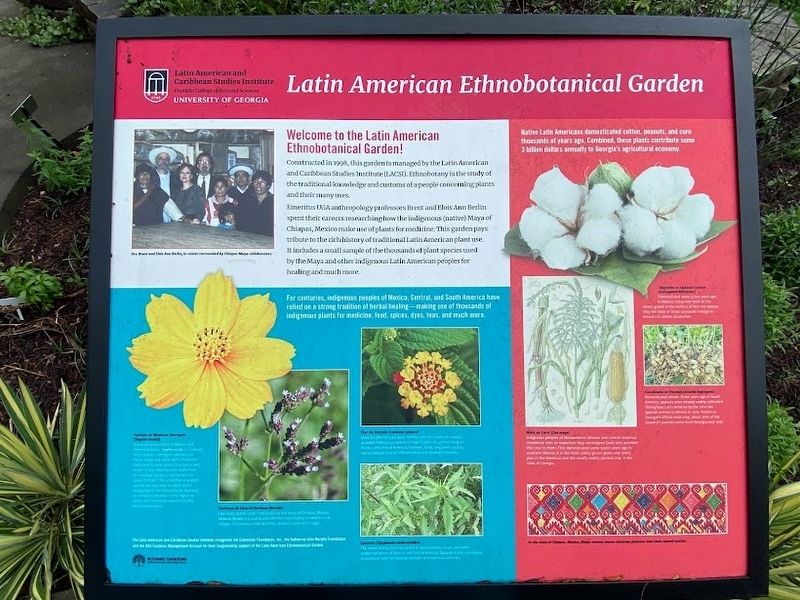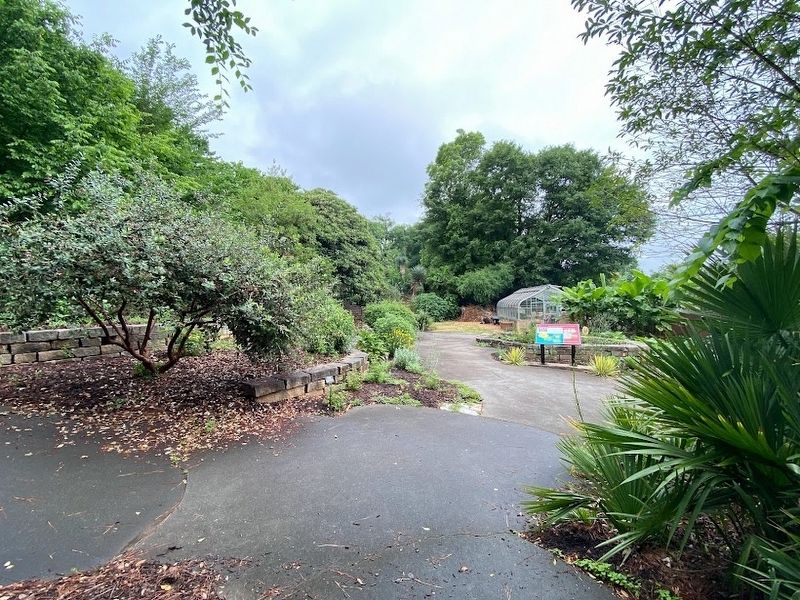Athens in Athens-Clarke County, Georgia — The American South (South Atlantic)
Latin American Ethnobotanical Garden
Welcome to the Latin American Ethnobotanical Garden!
Constructed in 1998, this garden is managed by the Latin American and Caribbean Studies Institute (LACSI). Ethnobotany is the study of the traditional knowledge and customs of a people concerning plants and their many uses.
Emeritus UGA anthropology professors Brent and Elois Ann Berlin spent their careers researching how the indigenous (native) Maya of Chiapas, Mexico make use of plants for medicine. This garden pays tribute to the rich history of traditional Latin American plant use. It includes a small sample of the thousands of plant species used by the Maya and other indigenous Latin American peoples for healing and much more.
For centuries, indigenous peoples of Mexico, Central, and South America have relied on a strong tradition of herbal healing-making use of thousands of indigenous plants for medicine, food, spices, dyes, teas, and much more.
Verbena de Litoral (Verbena litoralis)
Like many plants used medicinally by the Maya of Chiapas, Mexico, Verbena litoralis is a native and common weed easily located in rural villages. It is used to treat diarrhea, stomach pain, and cough.
Flor de Duende (Lantana camara)
Most Southerners are quite familiar with this plant as a readily available herbaceous perennial that flowers all summer long. In Mexico and Central America, however, it has long been used by native peoples to treat inflammation and stomach ailments.
Epazote (Dysphania ambrosioides)
The leaves of this plant are added to season beans, soups, and other traditional dishes of Mexico and Central America. Epazote is also considered an excellent herb for treating stomach and intestinal ailments.
Algodón or Upland Cotton (Gossypium hirsutum)
Domesticated some 5,000 years ago in Mexico, today over 90% of the cotton grown in the world is of this one species. Only the state of Texas surpasses Georgia in annual US. cotton production.
Cacahuate or Peanut (Arachis hypogees)
Domesticated almost 8,000 years ago in South America, peanuts were already widely cultivated throughout Latin America by the time the Spanish arrived to Mexico in 1519. Known as Georgia's official state crop, about 50% of the country's peanuts come from Georgia each year.
Maix or Corn (Zea mays)
Indigenous peoples of Mesoamerica (Mexico and Central America) considered corn so important they worshipped Gods who provided this crop to them. First domesticated some 9,000 years ago in southern Mexico, it is the most widely grown grain crop every year in the Americas and the mostly widely planted crop in the state of Georgia.
[Captions:]
Pericón or Mexican Tarragon (Tagetes lucida)
A popular plant native to Mexico and Central America, Tagetes lucida is a culinary herb used as a tarragon substitute to flavor soups and salsas and a medicinal herb used to treat stomach ailments and fevers. A tea called Pericón, made from the crushed leaves, is said to calm an upset stomach. This and other marigold species are also used to adorn altars during Day of the Dead (Dia de Muertos), an annual celebration in the region to honor and remember loved ones who have passed away.
Native Latin Americans domesticated cotton, peanuts, and corn thousands of years ago. Combined, these plants contribute some 3 billion dollars annually to Georgia's agricultural economy.
Erected by Latin American and Caribbean Studies Institute, University of Georgia.
Topics. This historical marker is listed in these topic lists: Agriculture • Anthropology & Archaeology • Colonial Era • Hispanic Americans • Horticulture & Forestry • Native Americans. A significant historical year for this entry is 1998.
Location. 33° 57.196′ N, 83° 22.303′ W. Marker is in Athens, Georgia, in Athens-Clarke County. Marker can be reached from the intersection of Baldwin Street and South Thomas Street, on the right when traveling west. Touch for map. Marker is at or near this postal address: 408 Baldwin St, Athens GA 30602, United States of America. Touch for directions.
Other nearby markers. At least 8 other markers are within walking distance of this marker. In Memory of Unknown Enslaved Individuals (about 300 feet away, measured in a direct line); Petroglyphic Boulders (about 300 feet away); United States Navy Pre-Flight School (about 300 feet away); Old Athens Cemetery (about 600 feet away); a different marker also named Old Athens Cemetery (about 600 feet away); Oconee Hill Cemetery (approx. 0.2 miles away); Old College (approx. ¼ mile away); Abraham Baldwin (approx. ¼ mile away). Touch for a list and map of all markers in Athens.
Credits. This page was last revised on April 29, 2023. It was originally submitted on April 29, 2023, by Darren Jefferson Clay of Duluth, Georgia. This page has been viewed 68 times since then and 20 times this year. Photos: 1, 2. submitted on April 29, 2023, by Darren Jefferson Clay of Duluth, Georgia. • Devry Becker Jones was the editor who published this page.

